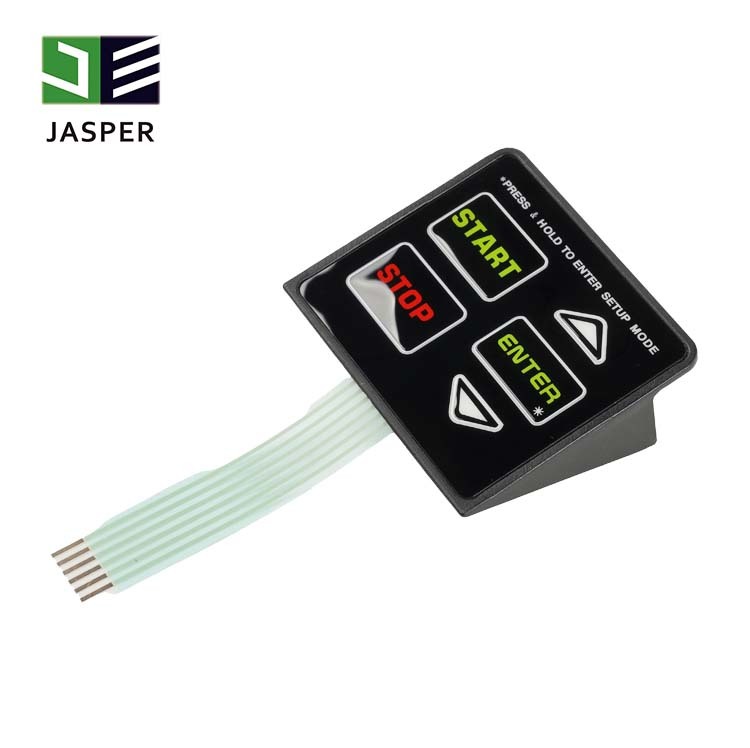Recognizing the Value of Membrane Change in Modern Electronics
Membrane buttons are important parts in modern digital tools. They use a mix of capability and design that improves individual communication. Their durable and lightweight nature makes them ideal for various applications. As sectors develop, the demand for modification and advanced attributes grows. Comprehending exactly how membrane layer changes add to advancement exposes their relevance fit the future of electronic devices. What exists ahead for this modern technology?
The Fundamentals of Membrane Layer Switch Over Technology
Often overlooked, membrane layer switch innovation plays a necessary function in the modern-day electronics landscape. These tools, composed of numerous layers, work as interface for various electronic items, ranging from home home appliances to medical devices. A typical membrane button includes a visuals overlay, a spacer layer, and a circuit layer, which are meticulously set up to create a practical interface.When stress is related to the overlay, the circuit layer is completed, allowing signals to be transferred to the tool. This technology is known for its convenience, enabling personalization in form, performance, and style to meet certain customer demands. In addition, membrane switches are slim and light-weight, making them ideal for applications where room is a premium. Their resilience and resistance to environmental aspects additionally improve their allure, guaranteeing they can withstand rough conditions while keeping capability. Overall, membrane button innovation is important to producing effective and straightforward digital devices

Secret Advantages of Membrane Switches
Membrane layer changes offer a number of essential advantages that make them a recommended option in various digital applications. Their style allows for a small type factor, making it possible for producers to create lightweight and sleek tools. Furthermore, membrane layer buttons are resistant to dirt, moisture, and chemicals, which improves their sturdiness and longevity popular atmospheres. The tactile comments provided by these buttons can boost customer experience, making them user-friendly and very easy to operate.Furthermore, membrane buttons can be customized with varied graphics and shades, permitting one-of-a-kind branding opportunities. The production procedure is typically cost-efficient, particularly for high-volume production, as it reduces assembly time and streamlines layout. Membrane changes call for very little maintenance, contributing to lower total functional costs. These advantages emphasize their growing appeal in contemporary electronics, where dependability and straightforward user interfaces are vital.

Applications Throughout Numerous Industries
The adaptability of membrane layer changes enables their widespread fostering across various markets. In the clinical field, they are commonly made use of in diagnostic tools and patient monitoring systems, offering a long lasting interface resistant to pollutants. The vehicle industry uses membrane switches for control panel controls, improving customer experience with sleek layouts that hold up against severe problems. In consumer electronic devices, they act as control board for devices such as microwaves and coffee manufacturers, offering an user-friendly user interface that is very easy to clean. The aerospace field utilizes membrane layer switches in cockpit controls, where reliability and room efficiency are vital. In addition, the industrial sector leverages these switches in equipment and control systems to assure durable operation sought after settings. This broad series of applications highlights the flexibility of membrane layer buttons, making them indispensable components in improving performance and customer interaction across varied technical landscapes.
Modification and Layout Versatility

Future Fads in Membrane Layer Switch Over Growth
Arising fads in membrane button growth show an expanding emphasis on enhanced functionality and assimilation with wise modern technologies. As customer need for extra innovative digital gadgets boosts, producers are concentrating on creating membrane switches that not just offer fundamental operational roles yet More Info additionally include attributes Discover More Here like touch level of sensitivity, backlighting, and haptic feedback.Furthermore, improvements in products are anticipated to boost longevity and ecological resistance, making membrane layer switches ideal for varied applications in industries such as medical care, automotive, and consumer electronic devices. The combination of capacitive touch technology is likely to become extra common, permitting sleeker designs and improved customer interfaces. membrane switch.Additionally, the increase of the Net of Things (IoT) is motivating the development of membrane layer switches that can interact wirelessly with other gadgets, boosting interconnectivity. Overall, the future of membrane layer switch modern technology appears encouraging, driven by technology and the pursuit of user-friendly solutions
Regularly Asked Questions
Just How Do Membrane Switches Contrast to Traditional Mechanical Switches?
Membrane layer switches, being more space-efficient and supplying a smooth layout, contrast with typical mechanical buttons that offer responsive feedback. The previous often feature personalized graphics, while the latter generally ensure durability and dependability in numerous applications.
What Products Are Commonly Used in Membrane Layer Switch Over Production?
Membrane layer switches are generally created using products such as polyester, polycarbonate, and published conductive inks. These materials offer flexibility, responsiveness, and resilience, making them appropriate for different applications in digital devices and interface.
Can Membrane Layer Changes Be Repaired or Recycled?
Membrane switches can often be repaired, especially if minor concerns emerge, such as glue failure or surface area damages. Complete reuse is typically restricted due to use and prospective degradation of products over time.
How Do Ecological Aspects Impact Membrane Layer Change Performance?
Environmental variables, such as humidity, direct exposure, and temperature to chemicals, greatly affect membrane layer switch efficiency. Severe conditions can lead to degradation, impacting responsiveness and long life, eventually compromising the functionality of the gadget in numerous applications.
What Is the Common Life-span of a Membrane Layer Switch over?
The common lifespan of a membrane button generally ranges from 1 to read the full info here 5 million actuations, depending on elements such as usage frequency, ecological conditions, and the materials used in manufacturing, impacting toughness and efficiency longevity. A common membrane switch is composed of a visuals overlay, a spacer layer, and a circuit layer, which are meticulously constructed to produce a practical interface - membrane switch.When stress is used to the overlay, the circuit layer is completed, permitting signals to be transmitted to the device. The tactile comments given by these buttons can boost customer experience, making them simple and intuitive to operate.Furthermore, membrane switches can be tailored with diverse graphics and colors, allowing for one-of-a-kind branding chances. As customer demand for a lot more innovative electronic gadgets rises, suppliers are concentrating on creating membrane changes that not only serve basic functional functions yet additionally integrate features like touch level of sensitivity, backlighting, and haptic feedback.Furthermore, advancements in materials are anticipated to improve sturdiness and ecological resistance, making membrane layer switches over appropriate for varied applications in sectors such as health care, vehicle, and consumer electronic devices. The combination of capacitive touch innovation is most likely to come to be much more common, permitting for sleeker designs and boosted user interfaces.Additionally, the surge of the Internet of Things (IoT) is motivating the development of membrane layer switches over that can connect wirelessly with various other devices, enhancing interconnectivity. Membrane buttons, being a lot more space-efficient and offering a streamlined style, contrast with conventional mechanical switches that supply responsive comments